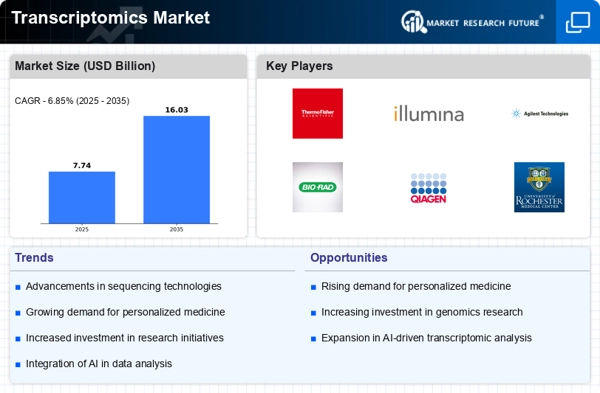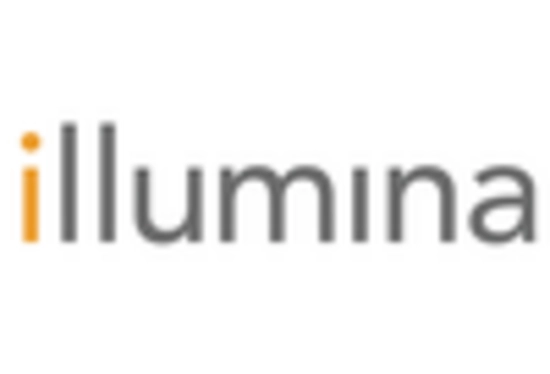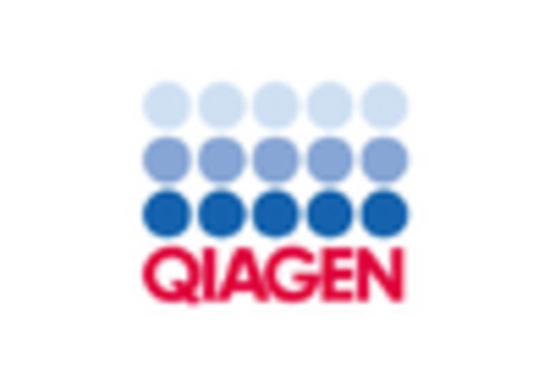Collaborative Research Initiatives
Collaborative research initiatives among academic institutions, biotechnology firms, and pharmaceutical companies are significantly influencing the Transcriptomics Market. These partnerships foster innovation and accelerate the development of novel transcriptomic applications. For instance, joint ventures focused on cancer research are utilizing transcriptomic data to uncover new therapeutic targets, thereby enhancing drug discovery processes. The increasing number of research publications in the field, which has seen a rise of over 30% in recent years, indicates a growing interest in transcriptomics. Such collaborations not only enhance the quality of research but also facilitate the sharing of resources and expertise, ultimately driving the growth of the Transcriptomics Market. As these initiatives continue to expand, they are expected to yield breakthroughs that will further propel market dynamics.
Rising Investment in Genomic Research
The Transcriptomics Market is benefiting from a surge in investment directed towards genomic research. Governments and private entities are increasingly allocating funds to support research initiatives aimed at understanding gene expression and its implications in health and disease. For example, funding for genomic research has seen an increase of approximately 25% in the last few years, reflecting a growing recognition of the importance of transcriptomics in biomedical research. This influx of capital is enabling the development of advanced technologies and methodologies, which are essential for comprehensive transcriptomic analysis. As a result, the Transcriptomics Market is likely to experience accelerated growth, driven by enhanced research capabilities and the potential for groundbreaking discoveries in various fields, including oncology and neurology.
Growing Demand for Personalized Medicine
The increasing emphasis on personalized medicine is a key driver in the Transcriptomics Market. As healthcare shifts towards tailored therapies, the need for precise gene expression profiling becomes paramount. Transcriptomics Market plays a crucial role in understanding individual patient responses to treatments, thereby facilitating the development of customized therapeutic strategies. The market for personalized medicine is expected to surpass 2 trillion USD by 2025, underscoring the potential for transcriptomic applications in drug development and patient management. This trend is further supported by the rising prevalence of chronic diseases, which necessitates a more individualized approach to treatment. Consequently, the Transcriptomics Market is likely to witness substantial growth as stakeholders seek to leverage transcriptomic insights for improved patient outcomes.
Increasing Applications in Drug Development
The expanding applications of transcriptomics in drug development are a significant driver for the Transcriptomics Market. Pharmaceutical companies are increasingly utilizing transcriptomic data to inform their drug discovery processes, leading to more effective and targeted therapies. The integration of transcriptomics into preclinical and clinical trials is becoming more prevalent, with an estimated 40% of new drug candidates incorporating transcriptomic analysis in their development. This trend is indicative of the growing recognition of the value of gene expression profiling in understanding drug mechanisms and patient responses. As the demand for innovative therapeutics continues to rise, the Transcriptomics Market is expected to flourish, driven by the critical role that transcriptomics plays in enhancing drug efficacy and safety.
Technological Advancements in Transcriptomics
The Transcriptomics Market is experiencing rapid growth due to technological advancements in sequencing technologies. Innovations such as next-generation sequencing (NGS) and single-cell RNA sequencing are revolutionizing the field, enabling researchers to analyze gene expression at unprecedented resolution. The market for NGS alone is projected to reach approximately 10 billion USD by 2026, indicating a robust demand for transcriptomic analysis. These advancements facilitate the identification of novel biomarkers and therapeutic targets, thereby enhancing the understanding of complex diseases. Furthermore, the integration of bioinformatics tools with transcriptomic data analysis is streamlining workflows, making it easier for researchers to interpret vast datasets. As a result, the Transcriptomics Market is poised for significant expansion, driven by the continuous evolution of these technologies.


















Leave a Comment